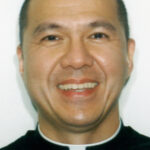By Corinne Winter
Traditionally, October was called the month of the most holy rosary with a memorial of Our Lady of the Rosary on Oct. 7 (subsumed this year by the Sunday liturgy). That title may raise a number of responses among Catholics of diverse backgrounds and experience. A significant number of Catholics remain dedicated to frequent recitation of the rosary either alone or with others and to encouraging others to adopt the custom. Others turn to the rosary as a source of consolation in especially difficult times. At the same time, even among strong practicing Catholics, some are puzzled or even put off by the idea of this “prayer to Mary.” Appreciation for the proper place of the rosary within Catholic spirituality may be enhanced by some insights into the history of the prayer.
 After Vatican II, Pope Paul VI wrote an apostolic exhortation on devotion to Mary. His purpose was to establish the rightful place of Marian prayer in opposition to two extreme positions he saw among Catholics of the time. On the one hand, some Catholics seemed to have dropped all forms of devotion to Mary and to other canonized saints as though they were relics of the past, no longer relevant in the light of more vibrant attention to the liturgy and to the central teachings of the church. Other Catholics were inclined to promote all forms of Marian piety almost as though they could take the place of liturgical prayer.
After Vatican II, Pope Paul VI wrote an apostolic exhortation on devotion to Mary. His purpose was to establish the rightful place of Marian prayer in opposition to two extreme positions he saw among Catholics of the time. On the one hand, some Catholics seemed to have dropped all forms of devotion to Mary and to other canonized saints as though they were relics of the past, no longer relevant in the light of more vibrant attention to the liturgy and to the central teachings of the church. Other Catholics were inclined to promote all forms of Marian piety almost as though they could take the place of liturgical prayer.
Growing up, I was told the story of Mary giving the rosary to St. Dominic in a vision and assumed that was where the prayer originated. But the actual story is much richer. The origin of the rosary is, in fact, connected to the monastic custom of praying the 150 psalms. Depending on the particular tradition of a monastic community, the psalms would be recited over a course of days, consecrating the hours and days to God. Efforts to make this custom accessible to both religious and lay people who for various reasons could not read or memorize all of the psalms led to the use of repetitive prayers in sets of 150. Some would pray 150 Our Fathers, using beads or stones to keep track of their progress. Others began to pray Hail Marys in a similar fashion, often interspersing short meditations on the life of Christ.
These sets of prayers persisted and developed in various forms over the course of several centuries. The term rosarium (“rose garden”) arose in reference to the collection of prayers and to the points of meditation. The form which we now identify as the rosary is traced to Dominic of Prussia, a Carthusian monk who, during the first half of the 15th century, popularized a set of 50 Hail Marys accompanied by 50 phrases related to the life of Mary and her Son. Another monk organized the Hail Marys into decades with an Our Father before each decade. Further modifications gave us the three sets of five “mysteries” from the life of Christ. Recitation of the “complete rosary” of all 15 decades included 150 Hail Marys (plus), retaining that seldom recognized connection with the praying of the 150 psalms.
Pope John Paul II in 2002 added the Luminous mysteries which call attention to key moments in the public ministry of Christ that were missing in the traditional sets of mysteries. He also recalled the teaching of Popes Paul VI (1974) and Pius V (1569) who insisted that praying the rosary included both the verbal repetition and meditation on the life of Christ. Thus, the rosary should be not prayer to Mary, but prayer in the company of Mary who is a sign of the church’s relationship with her son.
So the rosary developed as a way of prayer strongly connected with the liturgy of the church. It is identified as a form of “private” prayer because it not in itself liturgy. It is an option, not a requirement, but one very apt way of remaining connected with the core of our faith Tradition. There is not space within this short column to recount the many ways in which the experiences of different national and ethnic groups make the rosary and other forms of Marian devotion even more precious. But the church recognizes the value of popular spirituality and the insights it can provide into the way that our common faith is expressed in the lives of Catholics throughout the world.
(Corinne Winter is a professor-emeritus of St. Ambrose University, Davenport.)











